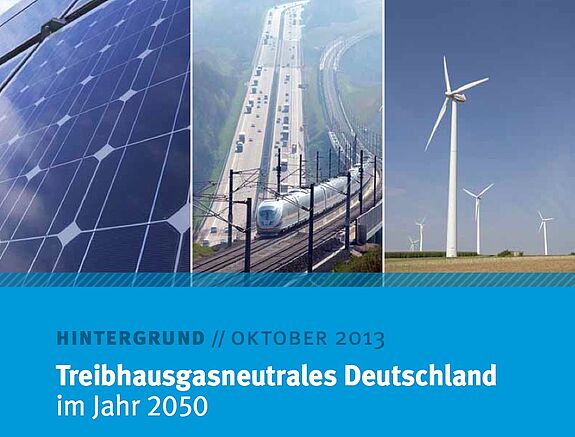According to a new study by the German Federal Environment Agency could become greenhouse neutral. Just using currently available technologies, emissions could be reduced by 95%. It‘s not just wishful thinking but actually possible. Germany could reduce its greenhouse gas emissions significantly - by up to 100% in 2050 compared to 1990. On the occasion of a two-day conference in Berlin, the Federal Environment Agency presented a study that analyzed the feasibility of an almost completely greenhouse gas-neutral industrial nation - a model that could possibly be adopted by other countries as well. “Our current annual per capita emissions of 10 tonnes of CO2 equivalents could be reduced to less than one ton per capita in 2050. Compared to 1990, that would be a reduction of 95 percent. Germany could become virtually greenhouse neutral by the middle of the century,“ said the UBA‘s President upon the publication of the UBA study “Greenhouse neutral Germany by 2050“.
To achieve true greenhouse gas neutrality, emissions in other countries would also have to be reduced – beyond their respective climate change commitments – to offset the remaining tonne per capita. „Energy is the decisive sector to set the right course for climate protection,“ said Flasbarth. „Electricity, heat and conventional fuels now account for about 80 per cent of our greenhouse gas emissions. But we can reduce our final energy consumption in 2050 by half compared to 2010, and we can cover our demand entirely with renewable sources of energy. We can already prevent more than three-quarters of emissions, and we do not need nuclear power or underground CO2 sequestration.“.
Convert power to gas
To achieve greenhouse gas neutrality in Germany it is crucial to convert power, which will be generated exclusively from renewable sources, into hydrogen, methane, and long-chained hydrocarbons. Solar and wind power are used in what is known as ‘power-to-gas’ and ‘power-to-liquid’ processes to produce methane or other liquid fuels by means of electrolysis of water or other catalytic processes. Solar and wind power are used in what is known as ‘power-to-gas’ and ‘power-to-liquid’ processes to produce methane or other liquid fuels by means of electrolysis or other catalytic processes. Some pilot schemes have already successfully implemented this technology. However, a large amount of energy is lost during conversion and the process is still expensive. Further research – including research into other options for transport and heating – needs to be carried out. The transportation industry currently accounts for about 20 % of the total emissions of greenhouse gases. These emissions can drop to zero by 2050 if the key condition is met – avoiding unnecessary use of transportation. If there is need for transportation, environmentally friendly solutions such as bicycle, bus or rail should be used whenever possible. Cars and trucks need to become more technically efficient. The key to a transportation industry without emissions is switching to renewable energy. According to Mr Flasbarth, in the scenario described by the German Federal Ministry of Environment, about 60 per cent of all passenger cars will have an electric motor by 2050. In the future, airplanes, ships and trucks will still mainly rely on liquid fuels, which will be synthetic, produced in the climate-friendly power-to-liquid process“. Whether and when these electricity-based fuels may be provided for different forms of transport is dependent on further research.
Heating with renewable gas
By 2050, industry demand for space heating and process heat could be met using renewable power and methane-generated renewable sources. As a result, the energy-related greenhouse gas emissions would drop to zero. Process- and raw material-based greenhouse gas emissions would by 75 percent, to approximately 14 million tons. Additionally, the chemical industry, whose raw material supply is largely petroleum-based, would have to refocus on renewably generated hydrocarbons. Thus there would be close to no greenhouse gas emissions when producing ammonia or in the course of any other chemical synthesis processes.. So far, emissions in the waste and wastewater sector have decreased dramatically. According to the UBA, they will only amount to three million tons of CO2 equivalents in 2050. To achieve this it will be necessary to capture even more landfill gases and to use them in cogeneration plants. In future, the improved ventilation of composting plants can help even more to prevent the formation of climate-damaging methane. In 2050, the largest emitter at 35 million tons CO2 equivalents may well be agriculture. Since technical measures are not enough to achieve the targeted reduction, it is necessary to reduce the animal population, especially ruminants.
What is possible and what is necessary
The Federal Environment Agency developed the scenarios based on the assumption that Germany will continue to be one of the leading industrialized countries in 2050. However, the study depicts only one possible outcome and is certainly not a prognosis of what will happen in the future. What is described in the study is a scenario for the year 2050 from a technical point of view. The study neither looks at how exactly the transformation from today until 2050 might take place nor does it assess economic costs and benefits. Furthermore, it also assumes that the consumer behaviour will not undergo fundamental changes. More climate- and environmentally friendly lifestyles would of course facilitate the achievement of climate protection goals.
The challenge of reducing greenhouse gas emissions by 95 percent is based on scientific research. This research is also the basis for the international agreement to limit the increase in global mean temperature to no more than 2 degrees Celsius. In order to achieve this goal, the greenhouse gas emissions worldwide have to be reduced by 50 percent by the middle of this century. For industrialized countries, this corresponds to a reduction in emissions by 80-95 percent in comparison to the data from 1990. Germany and the EU have changed their climate protection goals in response.

